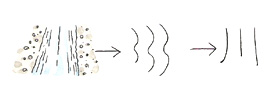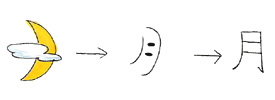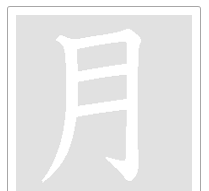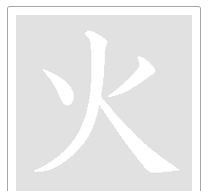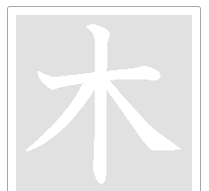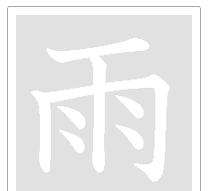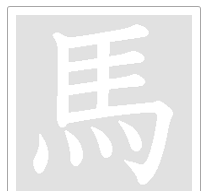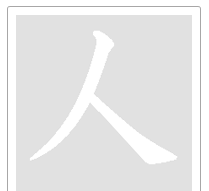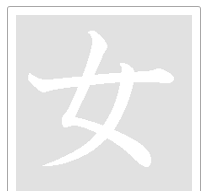 |
||||
 |
||||
Pictographs-1 |
|||||||||||||||||||||||||||
|
In Lesson 3 of
Step Up Nihongo (SUN) you find the two kanji 山
and 川
to represent a Japanese surname, Yamakawa.
In principle each kanji has two ways of being read. These are called on and kun readings. The on reading is considered by Japanese to be the original Chinese reading of the character. Of course, the on reading is distorted from the original Chinese sound because the Chinese and Japanese sound systems differ from each other. The kun reading is a Japanese word meaning what the kanji means; in the kun reading, the original meaning of the character is preserved, even though the pronunciation of it is entirely different from its original Chinese reading. |
|||||||||||||||||||||||||||
|
Examine the following kanji. 山 L3*meaning: mountain on reading: サン kun reading: やま |
|
|
|||||||||||||||||||||||||
|
* Note: The number, L3, mentioned beside each kanji indicates the Lesson from SUN where the kanji first appears. Take the kanji 山, for example. No doubt, this kanji was created from the shape of mountains. The on reading of this kanji is san, like Huji-san (Mt Fuji), while its kun reading is yama, which means "mountain" in Japanese. (For your information, 山 is pronounced "shan" in contemporary Mandarin Chinese.) To get 山 on the computer, enter yama or san, and choose this character. Practice getting 山, using the window provided below. Your PC should support Japanese characters. When handwriting kanji, the basic stroke order rules for katakana and hiragana hold true; in review, these were: from top to bottom, from left to right. So, when writing 山, draw the central vertical bar first from the top downward. Then make the left shorter vertical bar from top to bottom. Without lifting the pen continue horizontally to the right and stop. The last stroke is the right vertical bar from top to bottom to complete the character. Altogether, 山 is a three-stroke character. Practice writing this character using the video as your guide, and also handwrite it a number of times on the worksheet. |
|||||||||||||||||||||||||||
|
川 L3
meaning: river on reading: センkun reading: かわ |
|
|
|||||||||||||||||||||||||
|
Like 山, this kanji is obviously created from a simple drawing of what it stands for. Its on reading is sen while the kun reading is kawa, which means "river" in Japanese. The surname 山川 is therefore pronounced as Yamakawa (Mountain-River!). To get 川 on the computer, type kawa or sen, and choose this character.Practice getting 川, using the window provided below. Your PC should support Japanese characters. To handwrite 川 is not difficult. Just draw three vertical lines one by one starting from the left and moving right. The first stroke curves slightly away to the left. Practice writing this character using the video as your guide, and also handwrite it a number of times on the worksheet. Kanji of this type are called "pictographs" because they are simplified drawings of what is being "written". Just by looking at most of them, you will find that you can imagine how it was that the character was created and evolved. |
|||||||||||||||||||||||||||
|
日 L4 meaning: sun, day on reading: ニチ、ジツ kun reading:
ひ、ぴ、び、か |
|
|
|||||||||||||||||||||||||
|
Write the character in the window below. Your PC should support Japanese characters. | |||||||||||||||||||||||||||
|
月 L35 meaning: moon, month on reading: ガツ、ゲツ kun reading: つき
|
|
|
|||||||||||||||||||||||||
|
Write the character in the window below. Your PC should support Japanese characters. |
|||||||||||||||||||||||||||
|
火 L35 meaning: fire on reading: カ kun reading: ひ |
|
|
|||||||||||||||||||||||||
|
Write the character in the window below. Your PC should support Japanese characters. |
|||||||||||||||||||||||||||
|
木 L35 meaning: tree, wood on reading: モク kun reading: き |

|
|
|||||||||||||||||||||||||
|
Write the character in the window below. Your PC should support Japanese characters. |
|||||||||||||||||||||||||||
|
雨 L14 meaning: rain on reading: ウ kun reading: あめ
|
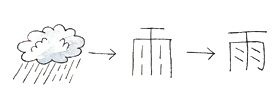
|
|
|||||||||||||||||||||||||
|
Write the character in the window below. Your PC should support Japanese characters. |
|||||||||||||||||||||||||||
|
馬 L29 meaning: horse on reading: マ、バ kun reading: うま |

|
|
|||||||||||||||||||||||||
|
Write the character in the window below. Your PC should support Japanese characters. |
|||||||||||||||||||||||||||
|
人 L12 meaning: person on reading: ニン、ジン kun reading: ひと
|
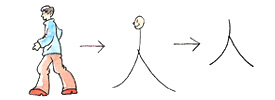
|
|
|||||||||||||||||||||||||
|
Write the character in the window below. Your PC should support Japanese characters. |
|||||||||||||||||||||||||||
|
女 L39 meaning: woman on reading: ジョ、ニョ kun reading:
おんな |
|
|
|||||||||||||||||||||||||
|
The shape of this character is said to represent a woman expecting a baby. Write the character in the window below. Your PC should support Japanese characters. |
|||||||||||||||||||||||||||
 |
|||||||||||||||||||||||||||




